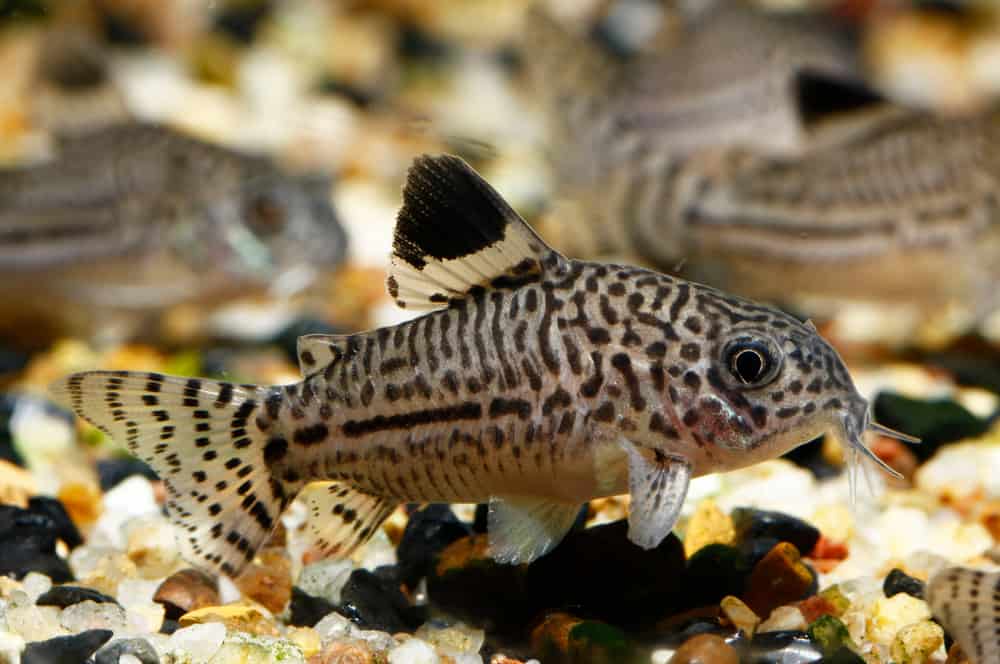Whether you call them Cory Catfish, Cory cats, or Corydoras Catfish, Corys are a favorite pet for many aquarist enthusiasts. They are many people’s first aquarium bottom feeder fish as they are both quite cute with their whiskers and they are fairly easy to look after. Still, like all fish, Cory Catfish require specific food and environment to have a long and healthy life. Let’s look into what do Cory Catfish eat and how to best take care of them.
Cory Catfish facts
When talking about Corys, the first thing to note is that there are a lot of them. As of today, there are over 170 recognized species of s of Corydoras, most of them with their own names such as Corydora hastasus, Corydora pygmaeus, etc. Of them, however, over 100 aren’t even named yet.
They all belong to the large Family Callichthyidae, however, known as just “Catfish” because of their cat-like whiskers. Callichthyidea actually comes from the Greek words Kallis (beautiful) and ichthys (fish).
Appearance and size
Depending on their exact species, Corydoras can be anywhere between 1 and 4 inches in length (2.5 to 10 cm). Female Corys are typically larger than male ones and are rarely under 3 inches, however. The two signature traits of Corys (and of most Catfish in general) are:
- A literal armor of bony plates covering their bodies
- Whiskers called barbels that the catfish use to “sniff” the bottom for any food they can scavenge
Both of these characteristics make for a pretty unique appearance, hence why Corys are so popular with aquarists.
Habitat
Corys are freshwater fish and they were originally found in the rivers and lakes of South America, all the way from the Andes Mountains to the coast of the Atlantic. Their natural habitat is at the bottom of freshwater bodies of water where they do their scavenging for food, breeding, and everything else.
Species of Cory Catfish
As we mentioned, more than half of the Cory Catfish species we know exist haven’t even been named yet nor are they therefore widely used as pets. Of the Corys we have named and know well, the most popular ones include:
1. Albino Cory
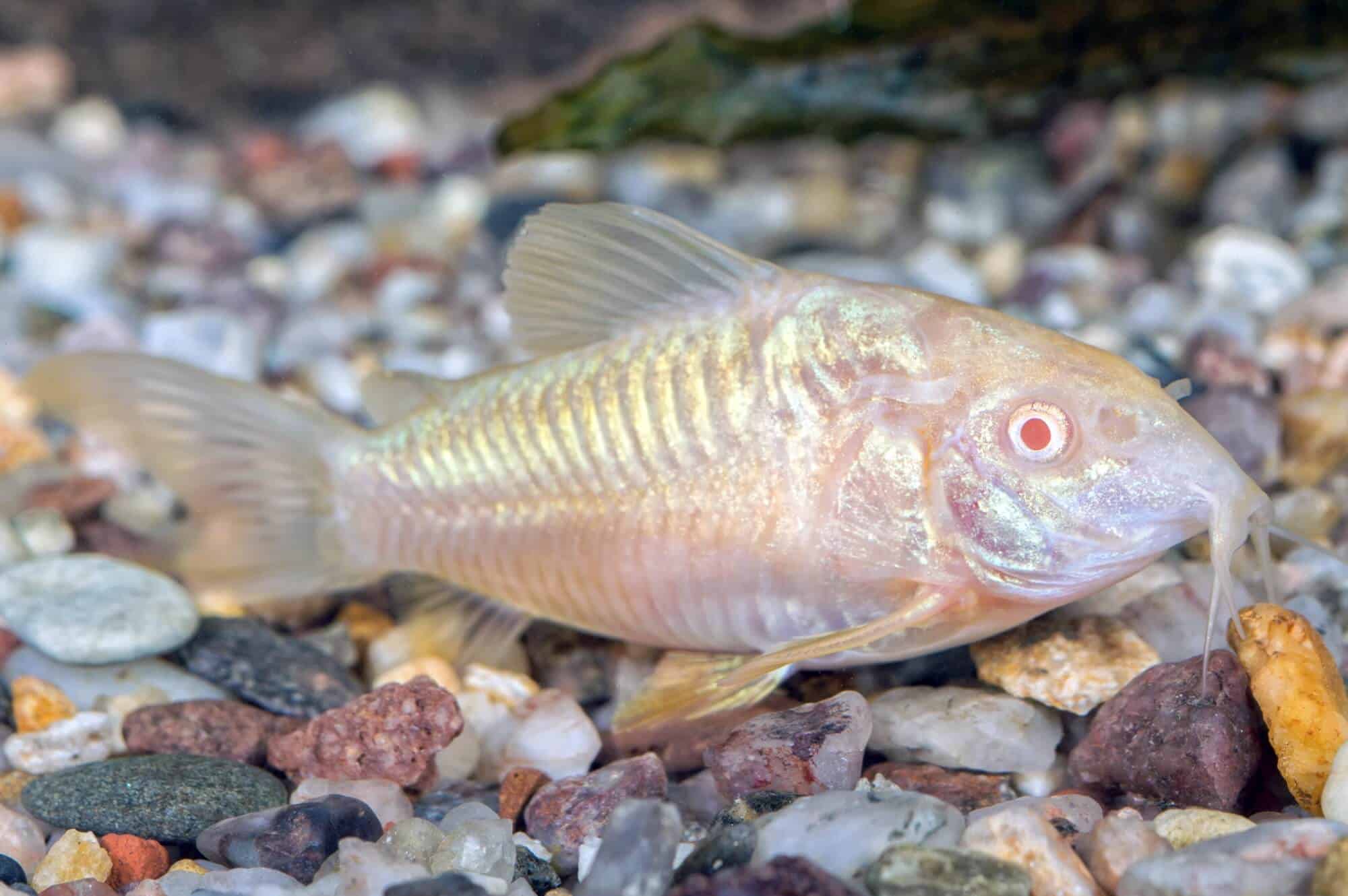
This is probably the most common Cory for first-time aquarists. Officially dubbed Corydoras aeneus, the Albino Cory has a striking whitish-pink color and red eyes. It is of medium size and typically grows up to 2.5 inches or 6.3 cm and it lives up to 10 years which is great for a small pet fish. Albino Corys are widely available in pet stores as is their bronze C. aeneus variant.
2. Bandit Cory
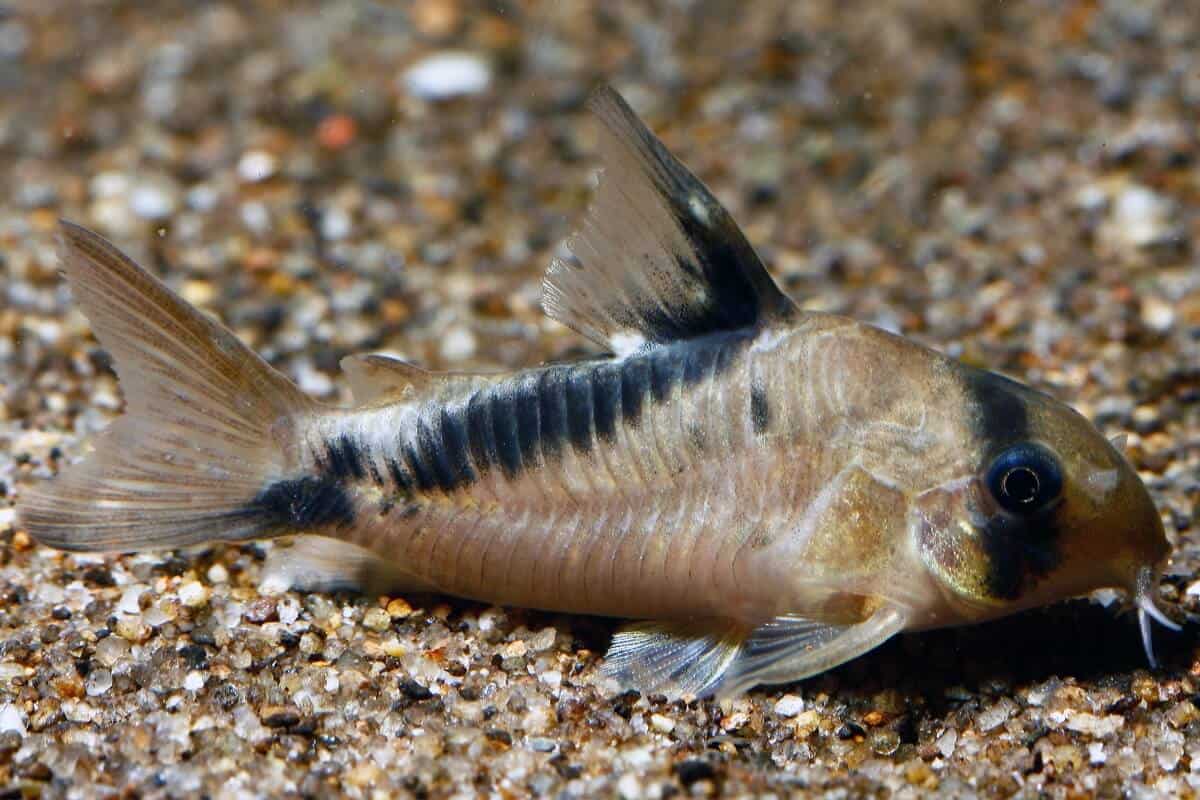
Also known as Cyrodoras metae, the Bandit Cory is called that way because of the black “mask” it has over its eyes. These Corys were first found in the Meta River region of Columbia but are now a very popular pet worldwide. They are fairly small too, only growing up to 1.8 inches in length or 4.5 cm.
3. Pigmy Cory
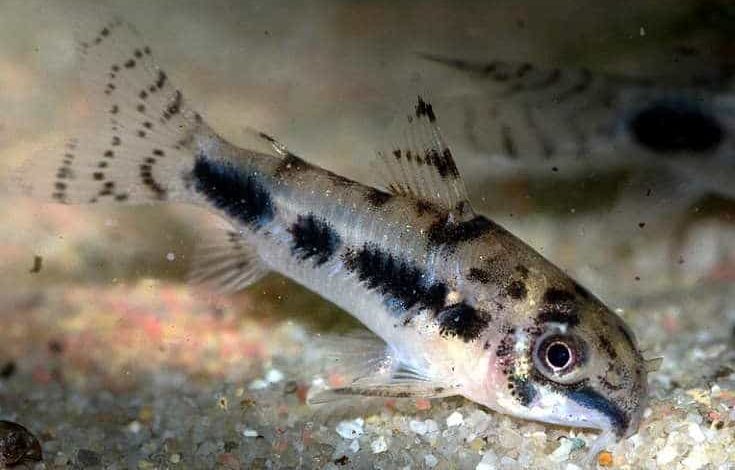
An even smaller catfish, the Pigmy Cory (Corydoras pygmaeus) only grows to about 1 inch (2.5 cm). This makes it a great choice if you only have space for a small aquarium at home. Native to Brazil, Peru, and Ecuador, Pigmy Corys have a nice silver body with a thin black strip going across its length.
4. Sterba’s Cory
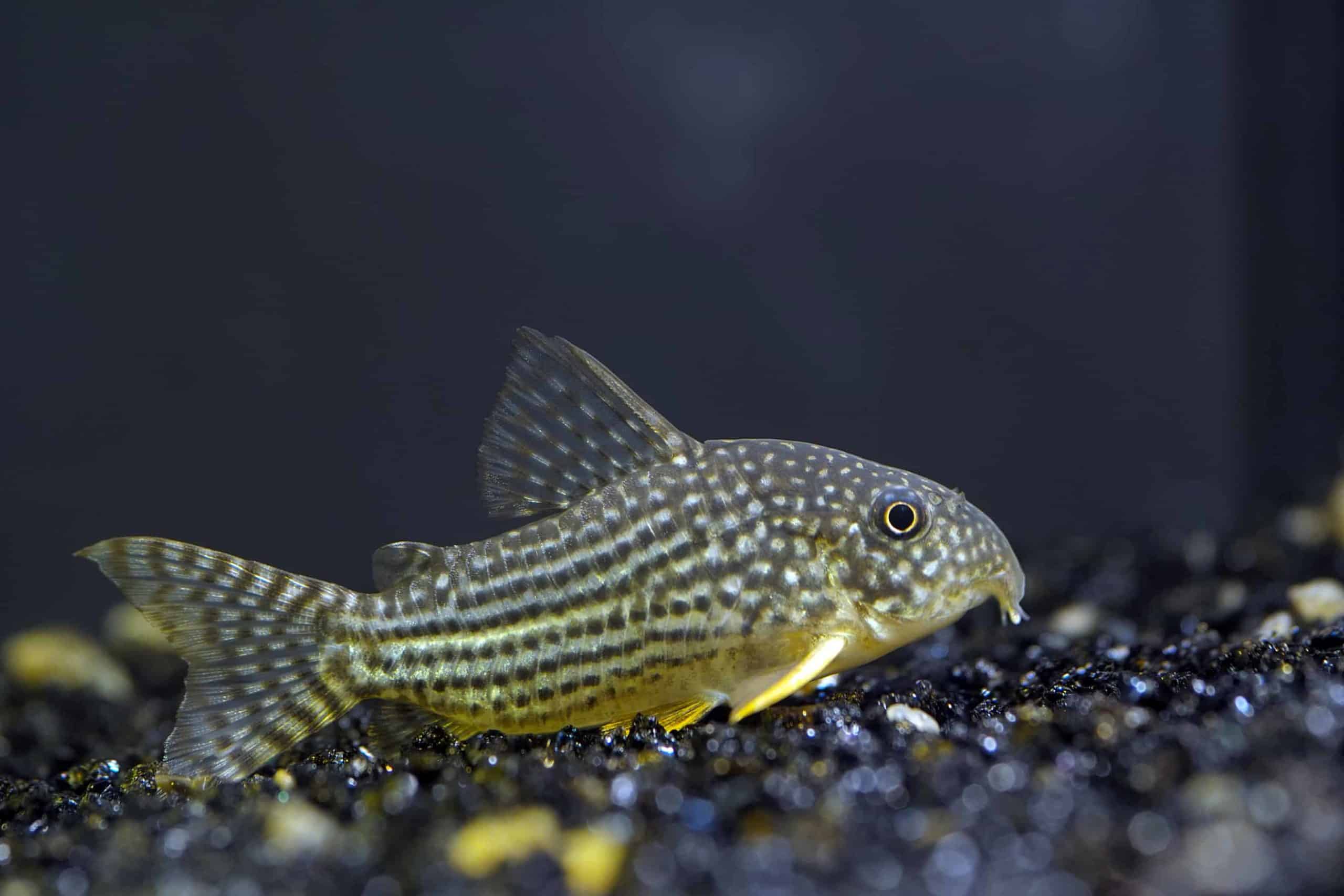
Corydoras sterbai has a cool and easily recognizable polka dot pattern on its body together with bright orange fins. They are easily adaptable to a wider range of water conditions (more on those below) and are therefore a great and common inclusion to many aquariums that need a bottom feeder to keep them clean. They are pretty mid-sized too as they grow to about 2.5 inches or 6.3 inches in length, just like the Albino Cory.
5. Leopard Cory
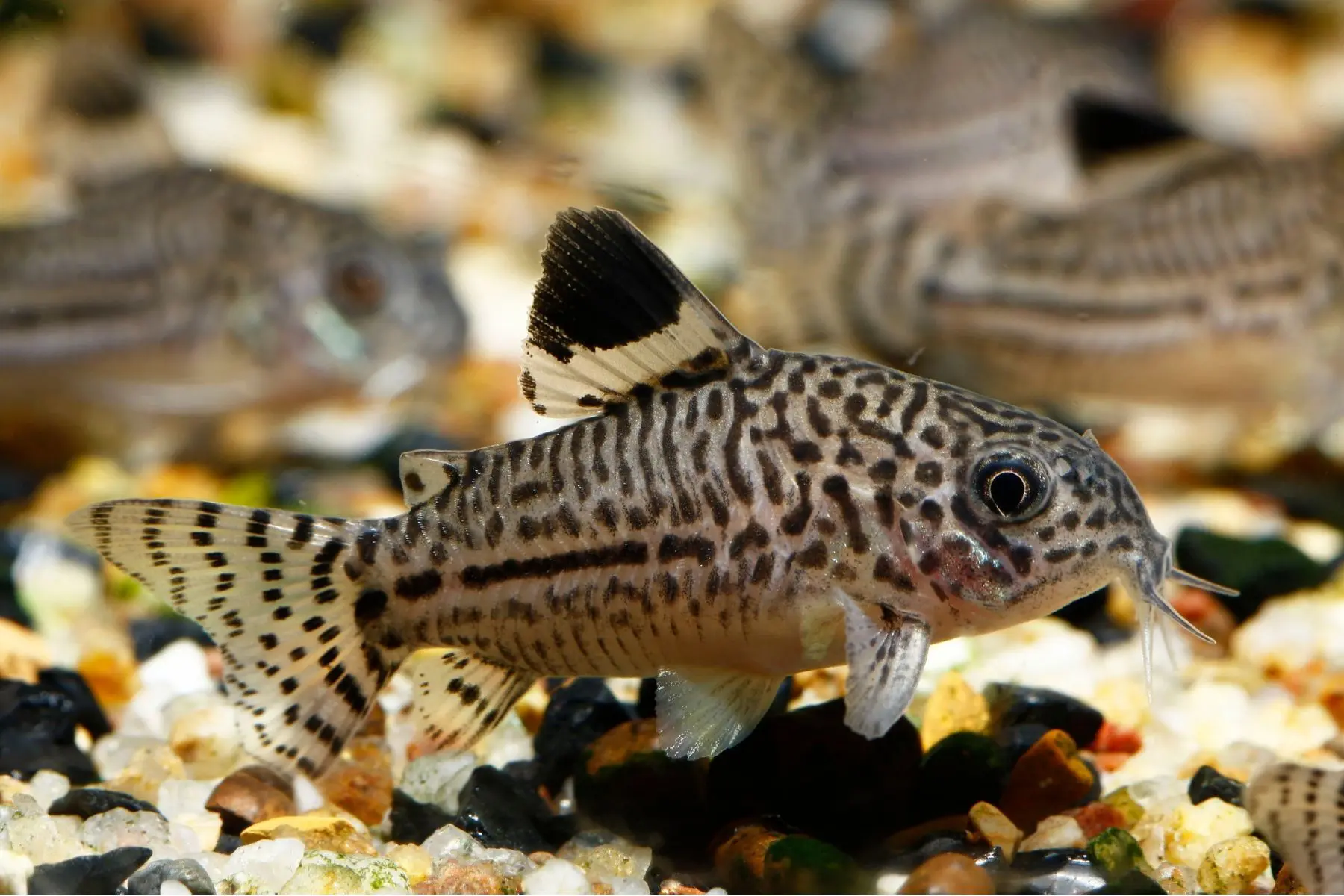
Called that way because of their spotted bodies, Corydoras trilineatus can tolerate slightly lower water temperatures and like to hang out in large groups. They are also often called “the false julii corydoras” or “the three-line catfish” and they grow to about 2.5 inches or 6.3 cm too.
What does Cory Catfish eat in their natural habitat?
As freshwater bottom feeders, all Cory Catfish thrive on scavenging the river beds they live in. Their wide menus include anything from bloodworms, snails, brine shrimp, ammonia, insect larvae, most bottom-dwelling insects, vegetable matter, and more. Needless to say, these fish aren’t picky eaters.
However, there is a common question of whether Cory Catfish eat algae too. The answer is no, even though Corys look like they do. Corys are bottom-feeders but they don’t eat algae in the wild and they will typically avoid doing so in aquariums. Corys can occasionally nibble on algae wafers by mistake as they sink to the bottom of the tank but will generally avoid doing so.
What does Cory Catfish eat in a tank?
Given how wide-ranging Corys’ diet is in the wild, this makes feeding them in captivity pretty easy too. You can feed your aquarium Cory almost any type of fish flakes, vegetables, worms, bottom feeder tablets, shrimp pellets, cucumber, white worms, zucchini, tubifex worms, betta food, small insects, romaine lettuce, and more.
Virtually any type of fish food that has enough protein, vitamins, and minerals, can be great food for your Cory as long as it’s not algae-based as most Corys will avoid that.
Of course, if your Cory doesn’t mind eating algae waffles, there’s nothing wrong in giving those too, they are not “unhealthy” for Corys in any way. However, if your Cory is only nibbling on them and doesn’t eat all of them, your tank will start getting dirty from the leftovers pretty soon.
Ideally, you should rotate your catfish’s food so that there’s plenty of diversity and proper nutrition. However, make sure that your pet eats everything you give it.
How much and how often should Corys be fed?
Cory Catfish should typically be fed once or twice a day but every day without a miss. The amount of food you should give your Cory is always “as much as it will eat immediately”. You don’t want to leave any extra food in the tank as you will either overfeed your Cory or you’ll get your tank too dirty – or both.
So, just observe how much your Corys eat in the first two or three minutes and that’s the quantity you want to give them twice a day.
That being said, if you have to travel, Corydoras Catfish can go on without food for a few days – up to 14 days, in fact, when need be. However, letting them stay hungry for that long is really ill-advised – Cory Catfish are pretty hardy but there’s no point pushing your luck. Going for a day or two without food shouldn’t be a problem for a healthy Cory but not more than that.
In other words, if you won’t be home for a day or two, you won’t need to have someone come over to feed your fish. If you need to be away for longer, however, make some arrangements so that your Corys are fed at least once a day.
Tank & Water requirements
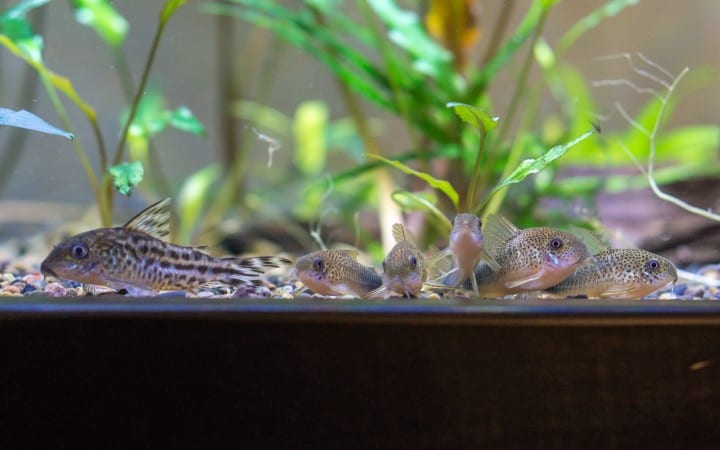
The standard recommendations for a Cory Catfish aquarium are a tank size of about 30 gallons. Some of the smaller Cory species such as C. habrosus, C. hastatus, or C. pygmaeus can live well in smaller aquariums too but a 30 gallon tank is still a good recommendation for them too.
When you get your first Cory some tank mates, you’ll notice that these fish like to congregate into groups, so, whatever gallon tank you’ve got it should have enough open areas for your school of Corys to comfortably swim around.
At the same time, the tank should have ample cover too so that your Corys can hide when they feel threatened or when they want a bit of privacy. The substrate at the bottom can be simple sand or fine gravel – just make sure that it is indeed fine and there aren’t any sharp edges on it or your Corys may hurt their barbels (whiskers) as they look for food in the aquarium’s floor.
As for the water parameters, you should generally aim for a pH between 7.0 and 8.0. The water alkalinity is best kept between 3° and 10° dKH (54ppm to 180ppm) while the temperature should go below or above 74° and 80° F (23.5° to 26.5° C). These are the ideal conditions for most captive-bred Cory catfish although wild-caught Corys may need a lower pH of 5.5 to 7.0 as well as alkalinity of 3° dKH (54ppm) or less.
Needless to say, you’d want to keep your Corys’ water as clean as possible. Excellent filtration is a must and you should always replace about 10% of the aquarium’s water every week. If you’re using tap water, remember to purify it with a good water conditioner before adding it to your Corys’ home.
What animals eat Cory Catfish?
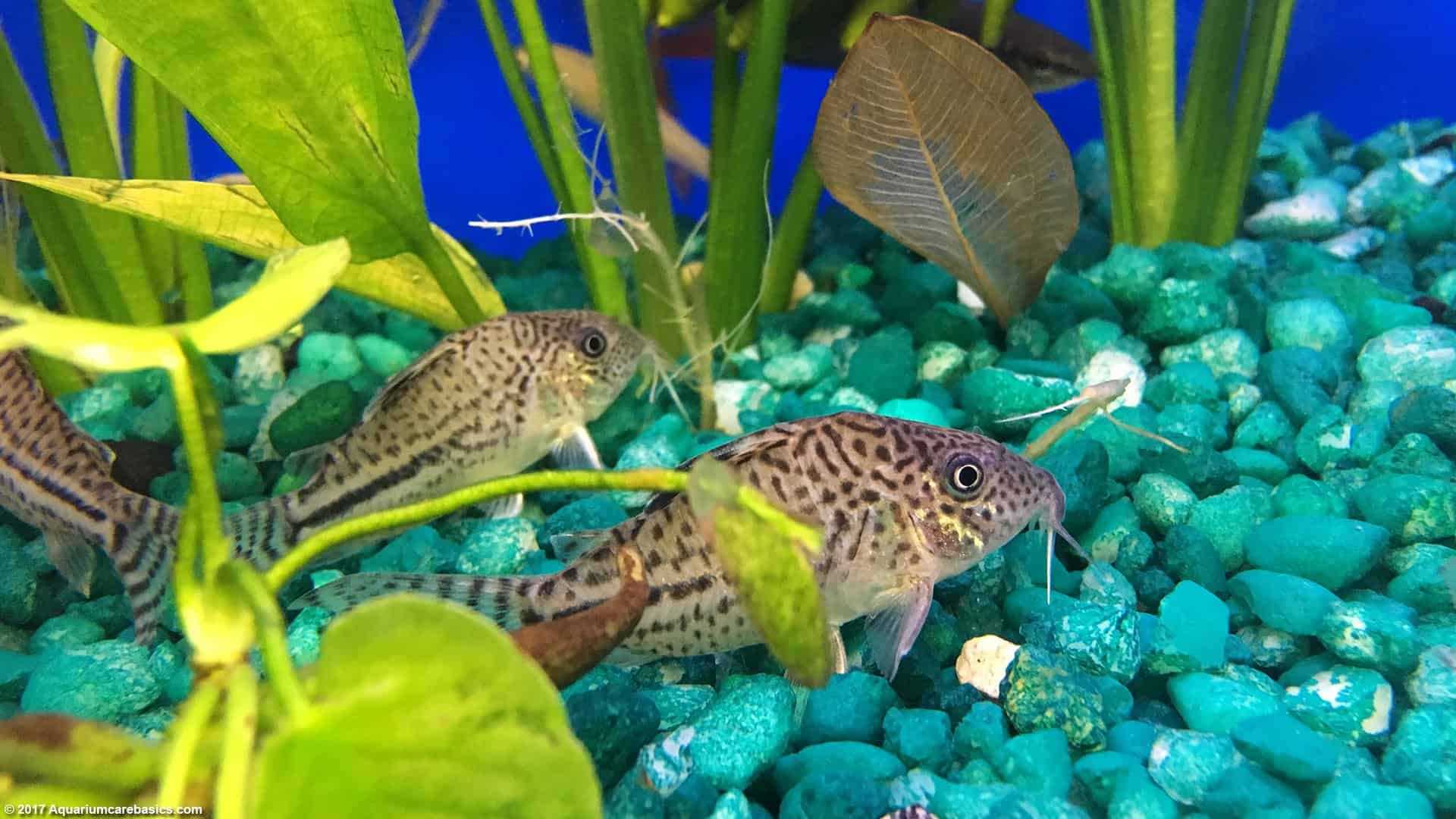
Cory Catfish do best when they have tank mates of both Catfish and other varieties. They are bottom feeders, after all, so they are an excellent fish to bring in with your other fish to keep the tank floor clean.
Yet, some fish are dangerous to keep together with others and even the hardy and well-armored Corys can become prey to some of their tank mates. The fish to never bring a Cory to include species such as the Texas Cichlids, Jack Dempseys, and Oscars. Even though the Cory fish have strong bodies, such predators can eat or at least harm them which isn’t great.
Additionally, even when a Cory falls prey to such a fish, they can also hurt them in return. Not only do Corys have strong and sharp fins and bone plates, but they also have a low level of body toxicity. Essentially, they are a bit poisonous to predators. What’s more, Corys can release a bit of those toxins in the water when they feel threatened.
This toxin-releasing trick is a good predator deterrence in the Corys’ wild river environment but can be a problem in an aquarium. What’s more, not only is this a problem for your other fish, it can be a problem for the Corys too as they are not immune to their own poison. So, since an aquarium’s water is stationary and doesn’t filter out as quickly as the water in a river, a scared Cory can essentially self-poison itself.
The avoid this, there are a few things to do:
- Make sure your Corys are safe and calm, especially when they are first introduced into their new environment
- Be certain that there aren’t any fish that would prey on your Cory in its new environment or that your Cory would perceive as potential threats
- Make sure that your Cory has plenty of hiding places in addition to the open areas at the bottom of the aquarium
- Be ready to replace your tank’s water if need be as that’s the best way to avoid your Cory self-poisoning itself
Generally speaking, however, Corys will get along with most non-aggressive and predatory pet fish types out there which is a big reason why they are so popular.
Conclusion
Corydoras Catfish are fantastic pets and excellent bottom-feeders that can fit in most home aquariums. They don’t need a lot of space as they are pretty small and they are very easy to feed as they are omnivore scavengers anyway.
So, as long as you maintain a good and clean water environment for them, get them together with the right tank mates, feed them regularly and well, and give them the right substrate and environment, your Cory Catfish should get to live long, healthy, and happy lives in their aquarium.
